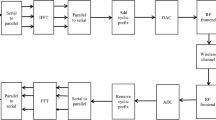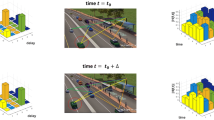Abstract
In this paper, we study a single carrier space–time block-spread (STBS) with frequency domain equalization combined with direct-spread code division multiple access (CDMA) which we term, SCFDE-STBS-CDMA. We propose a novel SCFDE space–time scheme for CDMA that achieves multiuser-interference free reception and performs well in both slow and fast fading frequency selective channel. The orthogonality among the users is preserved at the receiver allowing a multiuser-free MUI-free detection in slow fading channel. In fast fading channel, we proposed a MMSE detector that exploits the time diversity of the fast fading channels. In the conventional counterpart scheme proposed in the literature, the length of the spreading factor affect negatively the performance of the system when the channel is fast fading while in the proposed scheme, the spreading factor is an additional degree of freedom that do not degrade the system performance. Since the maximum number of users supported depends on the spreading factor, the proposed scheme can then maintain more users than the conventional one in fast fading channels. The bit-error rate (BER) performance of the proposed scheme is analyzed and compared with the conventional approach in the literature.
Similar content being viewed by others
References
Zhou S., Giannakis G. B., Le Martret C. (2002) Chip-interleaved block-spread code division multiple access. IEEE Transactions on Communications 50: 235–248
Wavegedara K. C. B., Djonin D., Bhargava V. K. (2005) Space–time-coded CDMA uplink transmission with MUI-free reception. IEEE Transaction on Wireless Communications 4: 3095–3105
Petre F., Leus G., Deneire L., Engels M., Moonen M., De Man H. (2003) Space–time block coding for single-carrier block transmission DS-CDMA downlink. IEEE Journal on Select Areas in Communications 21: 350–361
Madhukumar, T. S. D., Premkumar, A. S., & Peng, A. B. X. (2007). Space-frequency coded BS-CDMA for broadband mobile communication systems, wireless communications and networking conference (pp. 207–211).
Giannakis G. B., Wang Z., Scaglione A., Barbarossa S. (2000) AMOUR generalized multi-carrier transceivers for blind CDMA regardless of multipath. IEEE Transactions on Communications 48: 2064–2076
Leus G., Moonen M. (2000) MUI-free receiver for a synchronous DS-CDMA system based on block spreading in the presence of frequency-selective fading. IEEE Transactions on Signal Processing 48: 3175–3188
Viterbi A.J. (1995) CDMA: Principles of spread spectrum communication (1st ed.). Englewood Cliffs, Prentice Hall PTR ISBN 0201633744
Rohani, K., & Jalloul, L. (1997). Orthogonal transmit diversity for direct spread CDMA. In Proceedings of the ETSI SMG2, Stockholm, Sweden.
Brewer J. W. (1978) Kronecher products and matrix calculus in system theory. IEEE Transaction on Circuits Systems CAS-25: 772–781
Wang Z., Giannakis G. B. (2000) Wireless multicarrier communications: Where Fourier meets Shannon. IEEE Signal Processing Magazine 17: 29–48
Younis W. M., Sayed A. H., Al-Dhahir N. (2003) Efficient adaptive receivers for joint equalization and interference cancellation in multiuser space–time block-coded systems. IEEE Transactions On Signal Processing 5: 2849–2862
Markel J. D. (1971) FFT pruning. IEEE Transactions on Audio and Electroacoustics 19: 305–311
Oppenheim A. V., Schafer R. W. (1989) Discrete-time signal processing. Prentice Hall, Englewood Cliffs
Wang H. S., Chang P. C. (1996) On verifying the first order Markovian assumption for a Rayleigh fading channel model. IEEE Transactions on Vehicular Technology 45: 353–357
Marathe, D. V., & Bhashyam, S. (2005). Power control for multi-antenna Gaussian channels with delayed feedback. In Proceeding of the 39th Asilomar conference on signals, systems and computers (pp. 1598–1602).
Author information
Authors and Affiliations
Corresponding author
Rights and permissions
About this article
Cite this article
Acolatse, K., Bar-Ness, Y. Single Carrier Frequency Domain Equalization Space–Time Block-Spread CDMA with Multiuser Interference-Free Detection. Wireless Pers Commun 57, 481–499 (2011). https://doi.org/10.1007/s11277-010-0071-z
Published:
Issue Date:
DOI: https://doi.org/10.1007/s11277-010-0071-z




